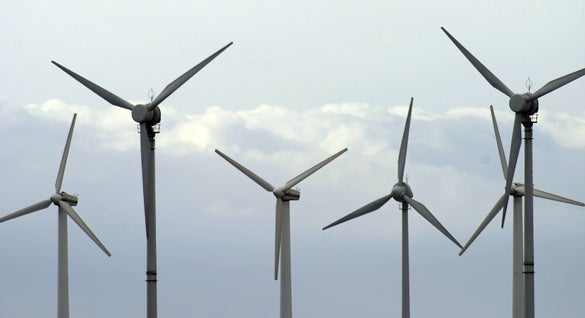In April, when Cape Wind finally got the federal approval it had been waiting for for nine years, it made large-scale harvesting of electricity from the wind look a lot more practical to a lot more people. But to some in Central Massachusetts, it wasn’t news that wind turbines can be a good choice for saving money.
Since 2008, the state’s net metering law has made it practical for many more organizations to generate energy and sell some of it back to the grid when their own needs are low. Across the region, from small single-turbine projects to the huge wind farm planned in Douglas, schools, communities and businesses are using wind power or actively getting ready to do so.
Below, we’ve cataloged the local projects that have passed the planning stages. In addition to these projects, there are also a number of projects in the initial planning and information-gathering stage.
Holy Name Central Catholic Junior/Senior High School
Since 2008, the Catholic school’s turbine has offered the most visible example of wind power in action from many vantage points in the city of Worcester.
For the school, part of the point of the $1.5 million, 600-kilowatt project is its visibility to much of a populous city. According to Holy Name’s website, the prominent placement helps raise visibility about wind power. It also provides an educational opportunity for students as well as real savings on the electrical bill.
That’s especially true since the state’s “net metering” rules allow the school to sell electricity back to the grid when the wind is blowing and school’s not in session. The wind power still benefits the school at night, on weekends and during school vacations.
Douglas Woods Wind Farm
This project, planned by Weymouth’s American Pro Wind, would be the largest land-based wind farm in the state. The developers have said the 11-turbine, $75 million project could be under construction by the end of the year. Once it’s completed, it could produce 27.5 megawatts, enough to power all of Douglas and Webster. The towers will stand 328 feet tall, with 164-foot blades. American Pro Wind has been working with the town on plans for the 300-acre parcel of open land since 2008. It’s now in the final stages of getting the approvals it needs to move forward.
Bay Path Technical High School
Another local school, Bay Path Regional Technical High School in Charlton, is constructing a 900-kilowatt turbine on campus. The school says the new wind power source should reduce its dependence on the grid by 86.9 percent. It also plans to incorporate the turbine into lessons for students and others in the local community. It was funded with the help of a $399,000 state grant.
Nature’s Classroom
Also in Charlton, the local campus of Nature’s Classroom Inc., a company that offers field trips and summer camp experiences for school children, has a 100-kilowatt turbine up and running. According to Northern Power Systems, the Vermont-based company that built the turbine, the system provides 10 percent of the organization’s power needs. That adds up to a savings of $17,000 in energy costs and 66 tons of carbon emissions.
Templeton Municipal Light and Water
This past spring, a 1.5-megawatt turbine started turning behind the Narragansett Regional Middle-High School in Templeton. The $3.7 million, 262-foot turbine provides power for Templeton, Phillipston and the Gardner Municipal Airport. The turbine provides 1.65 megawatts of power, which is equivalent to 5 percent of Templeton’s needs. Built by Solaya Energy of Woburn, it got support from a $400,000 grant from the Massachusetts Technology Collaborative.
Gardner
In the City of Gardner, four new 1.65- megawatt turbines are under construction, two at Mount Wachusett Community College and two at the North Central Correctional Institute. J.K. Scanlan Co. Inc. of East Falmouth received a $18.6 million contract to build the four windmills, which are scheduled to be completed by the end of the year. For the college, the construction of the turbines represents an expansion of a focus on renewable energy that has been growing for some time. The college was a pioneer in using a wood-powered biomass plant to heat the campus, which was originally designed for electrical heat. It now incorporates biomass heat and gasification technology as well as solar and wind into an education program focused on renewable power.
Princeton Municipal Light Department
Princeton was a wind power pioneer back in 1984 when it erected a public wind farm with eight 40-kilowatt turbines. In 2009, it became a leader again, replacing those relatively small and inefficient wind mills with two new 1.5-megawatt turbines. The town says the new wind mills have been generating more than 40 percent of its electrical needs, and the site is now the largest functioning wind farm in Central Massachusetts. The new turbines were installed on the top of Wachusett Mountain by Solaya Renewable Energy of Woburn. The light department has estimated they will take seven years to pay back their $7.3 million cost.

